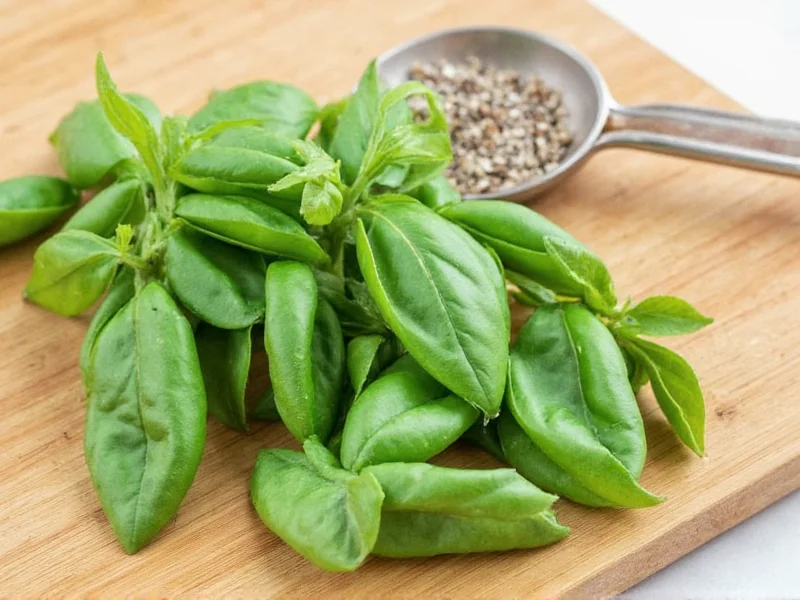When substituting dried basil for fresh in recipes, understanding proper herb conversion ratios is essential for achieving balanced flavors. Dried herbs contain less moisture and more concentrated flavor compounds than their fresh counterparts, requiring careful measurement adjustments.
Why the 3:1 Dried to Fresh Herb Ratio Matters
Drying removes approximately 80-90% of an herb's water content, concentrating its essential oils and flavor compounds. This scientific transformation explains why dried basil packs significantly more flavor intensity than fresh basil. When a recipe calls for 1 tsp dried basil, using an equivalent volume of fresh basil would result in noticeably weaker flavor.
Chef Marco Rodriguez, culinary instructor at the International Culinary Institute, explains: "The drying process intensifies certain flavor compounds while diminishing others. Basil loses some of its delicate volatile oils during drying, but concentrates its earthier notes. This chemical transformation necessitates precise measurement adjustments."
Complete Dried to Fresh Herb Conversion Chart
| Dried Herb Measurement | Fresh Herb Equivalent | Common Culinary Applications |
|---|---|---|
| 1/4 tsp dried basil | 3/4 tsp fresh basil | Sauces, dressings, delicate dishes |
| 1/2 tsp dried basil | 1 1/2 tsp fresh basil | Marinades, compound butters |
| 1 tsp dried basil | 1 tbsp (3 tsp) fresh basil | Pasta sauces, soups, stews |
| 1 1/2 tsp dried basil | 4 1/2 tsp fresh basil | Roasted vegetables, meat rubs |
| 1 tbsp dried basil | 3 tbsp fresh basil | Pizza toppings, hearty casseroles |
Practical Substitution Guidelines for Home Cooks
While the standard 3:1 ratio works for most applications, several factors influence optimal substitution:
- Recipe moisture content: In wet dishes like soups and stews, you can sometimes use slightly less fresh basil (2.5:1 ratio) since the liquid helps distribute flavor
- Flavor development time: Dried herbs benefit from longer cooking times to rehydrate and release flavors, while fresh herbs added late preserve brighter notes
- Herb quality: Older dried herbs lose potency—smell your dried basil; if aroma is weak, increase fresh substitution by 25%
- Culinary tradition: Italian recipes often prefer fresh basil for finishing dishes, while Mediterranean cuisines sometimes favor dried for certain preparations
Avoiding Common Herb Substitution Mistakes
Many home cooks make these critical errors when converting between dried and fresh basil:
- Using equal measurements: Treating 1 tsp dried basil the same as 1 tsp fresh results in under-seasoned dishes
- Adding fresh herbs too early: Delicate fresh basil loses flavor when cooked excessively—add in last 5-10 minutes
- Ignoring herb age: Dried herbs lose 30% potency annually—replace if older than 18 months
- Over-chopping fresh basil: Excessive cutting releases enzymes that cause browning—tear leaves instead
Optimal Storage for Maximum Flavor Preservation
Proper storage extends the shelf life and maintains the potency of both dried and fresh basil:
- Fresh basil: Store stems in water at room temperature (refrigeration causes blackening), cover loosely with plastic bag, change water every 2 days
- Dried basil: Keep in airtight container away from light and heat, ideally below 70°F (21°C), use within 12-18 months
- Freezing fresh basil: Blanch leaves briefly, pat dry, freeze in single layer then transfer to freezer bags for up to 6 months
- Dried herb testing: Rub between fingers—if aroma is faint, potency has diminished significantly
When to Adjust the Standard Conversion Ratio
Certain culinary situations warrant modifying the standard 1 tsp dried basil to fresh conversion:
- Raw applications: For salads or garnishes, use 4:1 ratio (1 tsp dried = 4 tsp fresh) since cooking doesn't concentrate fresh herb flavors
- Delicate dishes: In light sauces or seafood preparations, reduce fresh basil by 25% to prevent overpowering subtle flavors
- Long-cooked dishes: For recipes simmering over 2 hours, increase fresh basil by 20% as some volatile compounds evaporate during cooking
- Personal preference: Taste as you go—some palates prefer more pronounced herbal notes than others
Professional Chef Tips for Perfect Herb Integration
Master chefs employ these techniques when working with basil conversions:
"For tomato-based sauces, I actually prefer using a combination—half dried for depth during cooking, half fresh added at the end for brightness. This layered approach creates more complex flavor profiles than using either form exclusively." — Chef Elena Martinez, James Beard Award nominee
Consider these professional insights when converting between dried and fresh basil measurements:
- Crush dried basil between your fingers before adding to release maximum flavor
- For pesto, always use fresh basil—dried won't emulsify properly with oils
- When substituting in baking recipes, reduce liquid by 1-2 teaspoons per tablespoon of fresh basil added
- Grow your own basil for peak freshness—harvest in morning when essential oil concentration is highest











 浙公网安备
33010002000092号
浙公网安备
33010002000092号 浙B2-20120091-4
浙B2-20120091-4